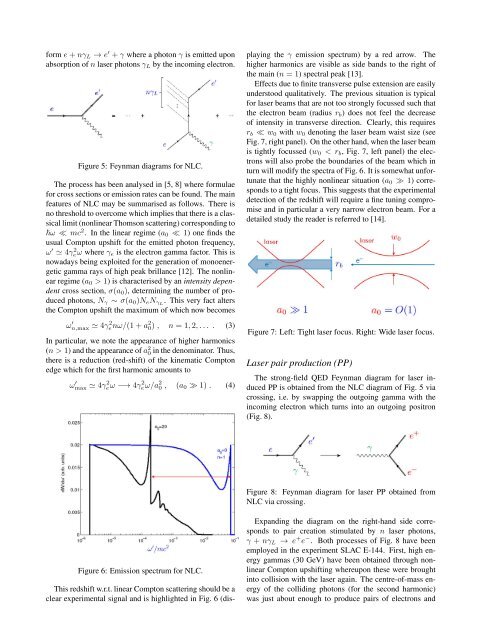Proceedings of International Conference on Physics in ... - KEK
Proceedings of International Conference on Physics in ... - KEK
Proceedings of International Conference on Physics in ... - KEK
You also want an ePaper? Increase the reach of your titles
YUMPU automatically turns print PDFs into web optimized ePapers that Google loves.
form e + nγL → e ′ + γ where a phot<strong>on</strong> γ is emitted up<strong>on</strong><br />
absorpti<strong>on</strong> <str<strong>on</strong>g>of</str<strong>on</strong>g> n laser phot<strong>on</strong>s γL by the <strong>in</strong>com<strong>in</strong>g electr<strong>on</strong>.<br />
Figure 5: Feynman diagrams for NLC.<br />
The process has been analysed <strong>in</strong> [5, 8] where formulae<br />
for cross secti<strong>on</strong>s or emissi<strong>on</strong> rates can be found. The ma<strong>in</strong><br />
features <str<strong>on</strong>g>of</str<strong>on</strong>g> NLC may be summarised as follows. There is<br />
no threshold to overcome which implies that there is a classical<br />
limit (n<strong>on</strong>l<strong>in</strong>ear Thoms<strong>on</strong> scatter<strong>in</strong>g) corresp<strong>on</strong>d<strong>in</strong>g to<br />
ω ≪ mc2 . In the l<strong>in</strong>ear regime (a0 ≪ 1) <strong>on</strong>e f<strong>in</strong>ds the<br />
usual Compt<strong>on</strong> upshift for the emitted phot<strong>on</strong> frequency,<br />
ω ′ 4γ2 eω where γe is the electr<strong>on</strong> gamma factor. This is<br />
nowadays be<strong>in</strong>g exploited for the generati<strong>on</strong> <str<strong>on</strong>g>of</str<strong>on</strong>g> m<strong>on</strong>oenergetic<br />
gamma rays <str<strong>on</strong>g>of</str<strong>on</strong>g> high peak brillance [12]. The n<strong>on</strong>l<strong>in</strong>ear<br />
regime (a0 > 1) is characterised by an <strong>in</strong>tensity dependent<br />
cross secti<strong>on</strong>, σ(a0), determ<strong>in</strong><strong>in</strong>g the number <str<strong>on</strong>g>of</str<strong>on</strong>g> produced<br />
phot<strong>on</strong>s, Nγ ∼ σ(a0)NeNγL . This very fact alters<br />
the Compt<strong>on</strong> upshift the maximum <str<strong>on</strong>g>of</str<strong>on</strong>g> which now becomes<br />
ω ′ n,max 4γ 2 enω/(1 + a 2 0) , n = 1, 2, . . . . (3)<br />
In particular, we note the appearance <str<strong>on</strong>g>of</str<strong>on</strong>g> higher harm<strong>on</strong>ics<br />
(n > 1) and the appearance <str<strong>on</strong>g>of</str<strong>on</strong>g> a 2 0 <strong>in</strong> the denom<strong>in</strong>ator. Thus,<br />
there is a reducti<strong>on</strong> (red-shift) <str<strong>on</strong>g>of</str<strong>on</strong>g> the k<strong>in</strong>ematic Compt<strong>on</strong><br />
edge which for the first harm<strong>on</strong>ic amounts to<br />
ω ′ max 4γ 2 eω −→ 4γ 2 eω/a 2 0 , (a0 ≫ 1) . (4)<br />
Figure 6: Emissi<strong>on</strong> spectrum for NLC.<br />
This redshift w.r.t. l<strong>in</strong>ear Compt<strong>on</strong> scatter<strong>in</strong>g should be a<br />
clear experimental signal and is highlighted <strong>in</strong> Fig. 6 (dis-<br />
play<strong>in</strong>g the γ emissi<strong>on</strong> spectrum) by a red arrow. The<br />
higher harm<strong>on</strong>ics are visible as side bands to the right <str<strong>on</strong>g>of</str<strong>on</strong>g><br />
the ma<strong>in</strong> (n = 1) spectral peak [13].<br />
Effects due to f<strong>in</strong>ite transverse pulse extensi<strong>on</strong> are easily<br />
understood qualitatively. The previous situati<strong>on</strong> is typical<br />
for laser beams that are not too str<strong>on</strong>gly focussed such that<br />
the electr<strong>on</strong> beam (radius rb) does not feel the decrease<br />
<str<strong>on</strong>g>of</str<strong>on</strong>g> <strong>in</strong>tensity <strong>in</strong> transverse directi<strong>on</strong>. Clearly, this requires<br />
rb ≪ w0 with w0 denot<strong>in</strong>g the laser beam waist size (see<br />
Fig. 7, right panel). On the other hand, when the laser beam<br />
is tightly focussed (w0 < rb, Fig. 7, left panel) the electr<strong>on</strong>s<br />
will also probe the boundaries <str<strong>on</strong>g>of</str<strong>on</strong>g> the beam which <strong>in</strong><br />
turn will modify the spectra <str<strong>on</strong>g>of</str<strong>on</strong>g> Fig. 6. It is somewhat unfortunate<br />
that the highly n<strong>on</strong>l<strong>in</strong>ear situati<strong>on</strong> (a0 ≫ 1) corresp<strong>on</strong>ds<br />
to a tight focus. This suggests that the experimental<br />
detecti<strong>on</strong> <str<strong>on</strong>g>of</str<strong>on</strong>g> the redshift will require a f<strong>in</strong>e tun<strong>in</strong>g compromise<br />
and <strong>in</strong> particular a very narrow electr<strong>on</strong> beam. For a<br />
detailed study the reader is referred to [14].<br />
Figure 7: Left: Tight laser focus. Right: Wide laser focus.<br />
Laser pair producti<strong>on</strong> (PP)<br />
The str<strong>on</strong>g-field QED Feynman diagram for laser <strong>in</strong>duced<br />
PP is obta<strong>in</strong>ed from the NLC diagram <str<strong>on</strong>g>of</str<strong>on</strong>g> Fig. 5 via<br />
cross<strong>in</strong>g, i.e. by swapp<strong>in</strong>g the outgo<strong>in</strong>g gamma with the<br />
<strong>in</strong>com<strong>in</strong>g electr<strong>on</strong> which turns <strong>in</strong>to an outgo<strong>in</strong>g positr<strong>on</strong><br />
(Fig. 8).<br />
Figure 8: Feynman diagram for laser PP obta<strong>in</strong>ed from<br />
NLC via cross<strong>in</strong>g.<br />
Expand<strong>in</strong>g the diagram <strong>on</strong> the right-hand side corresp<strong>on</strong>ds<br />
to pair creati<strong>on</strong> stimulated by n laser phot<strong>on</strong>s,<br />
γ + nγL → e + e − . Both processes <str<strong>on</strong>g>of</str<strong>on</strong>g> Fig. 8 have been<br />
employed <strong>in</strong> the experiment SLAC E-144. First, high energy<br />
gammas (30 GeV) have been obta<strong>in</strong>ed through n<strong>on</strong>l<strong>in</strong>ear<br />
Compt<strong>on</strong> upshift<strong>in</strong>g whereup<strong>on</strong> these were brought<br />
<strong>in</strong>to collisi<strong>on</strong> with the laser aga<strong>in</strong>. The centre-<str<strong>on</strong>g>of</str<strong>on</strong>g>-mass energy<br />
<str<strong>on</strong>g>of</str<strong>on</strong>g> the collid<strong>in</strong>g phot<strong>on</strong>s (for the sec<strong>on</strong>d harm<strong>on</strong>ic)<br />
was just about enough to produce pairs <str<strong>on</strong>g>of</str<strong>on</strong>g> electr<strong>on</strong>s and













